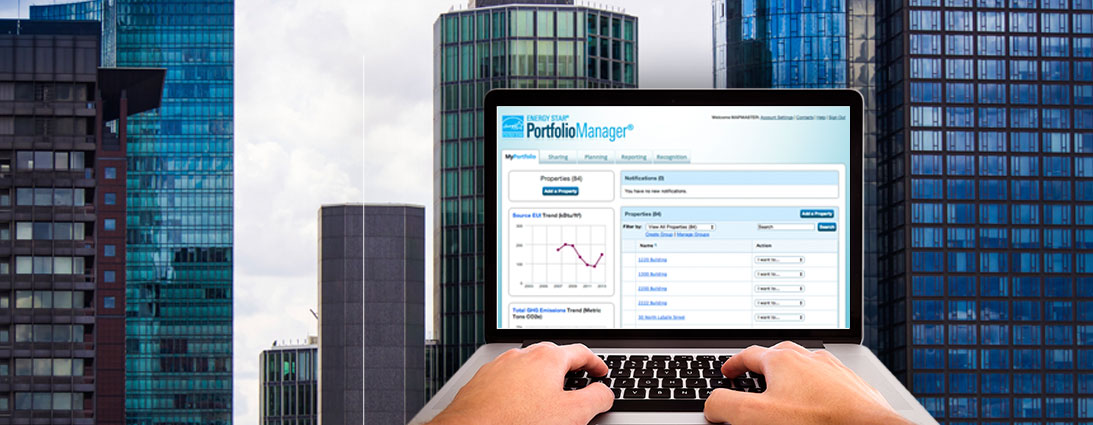

By Rebecca Sappenfield Baptiste
Whether you own your own building or are a commercial tenant, you pay for your business’s energy consumption. But do you truly understand how much energy your business space is using over time and how you might use that information to become aware of potential savings opportunities?
The average commercial building wastes 30 percent of its energy consumption, according to the U.S. Environmental Protection Agency (EPA). The first step to cutting waste and saving money is to measure and track your building’s energy use, a practice called building energy benchmarking.
Like miles-per-gallon ratings for cars, benchmarking documents energy use and provides a means to compare your consumption to past performance and to similar businesses and buildings to gauge energy performance.
Benchmarking a building, a portfolio of buildings or a tenant space is relatively easy when using the industry-leading tool, ENERGY STAR® Portfolio Manager®, provided at no cost by the EPA. Nationwide, more than 40 percent of commercial building space owners and operators are already benchmarking using Portfolio Manager.
Originally published Oct. 8, 2018, in the San Diego Business Journal special section “Sustainable San Diego.”
Who is Required to Benchmark?
Increasingly, local jurisdictions nationwide are requiring building owners and operators to track energy consumption to better understand the energy performance of their community’s building stock. Some jurisdictions, such as the City of Berkeley, also require a thorough energy audit or assessment to identify specific savings opportunities in a building.
In California, owners of large commercial (greater than 50,000 square feet) and multifamily properties (greater than 50,000 square feet and with 17 or more residential units) are required to benchmark under state legislation Assembly Bill 802. The first reporting deadline for those commercial buildings was June 1, 2018, but the California Energy Commission is still accepting 2018 submissions past the deadline. Next year, all multifamily properties will be required to report their energy consumption to the Energy Commission. Beginning in the second year of reporting and for subsequent years, data will be disclosed publicly on the commission’s website.
Locally, the City of San Diego is moving forward with a proposed local commercial and multifamily building energy benchmarking ordinance in support of its climate action plan goals. In July, staff presented a draft ordinance to the city’s Environment Committee for review, and they approved it to move forward to a city council vote. The ordinance will align with state requirements, providing local building owners the opportunity to report locally versus to the state. To learn about the ordinance and sign up for email updates on its progress toward a council vote, visit SanDiego.gov/Benchmark.
How to Access Utility Data
Those who own all their meters for their tenant space or building can either choose to enter energy consumption data manually into Portfolio Manager directly from a paper bill or synchronize online utility billing information directly with San Diego Gas & Electric (SDG&E).
If you have multiple tenants in your buildings with separate meters, under state regulations, you can access whole-building aggregated energy consumption information directly from SDG&E. As long as there are three or more accounts at your property (commercial buildings) or five or more accounts (multifamily and mixed-use properties), you can submit a request through SDG&E’s newly launched Benchmarking Data Request Portal at SDGE.com/benchmarking.
Turn Knowledge into Savings
After you gather at least twelve months of your energy consumption data, as well as a few key building details, like number of operating hours and gross floor area, you can benchmark your building and receive either an energy use intensity rating (energy used per square foot) or an ENERGY STAR score (1-100). This number lets you know how your building is performing compared to similar buildings nationwide and is normalized for differing use details and local weather conditions. With this information, you can work with your building operations staff or an energy consultant or contractor to identify and pursue energy efficiency projects in your building and track the impacts of those projects directly in Portfolio Manager.
Taking the Next Steps
The Center for Sustainable Energy, on behalf of the San Diego Regional Energy Partnership, provides no-cost, one-on-one technical support to members of the San Diego Regional Green Business Network. Our benchmarking coaches offer the following services to help member businesses begin benchmarking.
- Create a Portfolio Manager account
- Add properties to your Portfolio Manager account
- Input energy and water consumption data
- Share your data with other people and services
- Set up automatic data transfer with SDG&E
- Generate reports on your property’s data
- Identify next steps for pursuing energy efficiency projects
To gain access to this exclusive benefit, your business must join the San Diego Regional Green Business Network (SDRGBN) at GreenBizSD.org/join. Membership is free and provides additional benefits such as a bimonthly newsletter, sustainability tips for businesses and access to member events. In October, the network will tour the water- and energy-efficient Stone Brewing World Bistro and Gardens in Escondido.
You can learn more about local and statewide energy regulations, benchmarking coach services and the San Diego Regional Green Business Network by visiting GreenBizSD.org online or by emailing Benchmarking@GreenBizSD.org.
Rebecca Sappenfield Baptiste, LEED AP O&M, is associate manager of CSE's Advisory Services.

